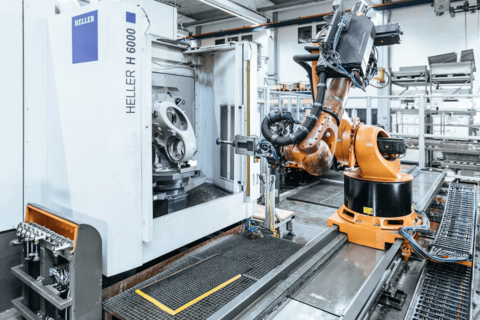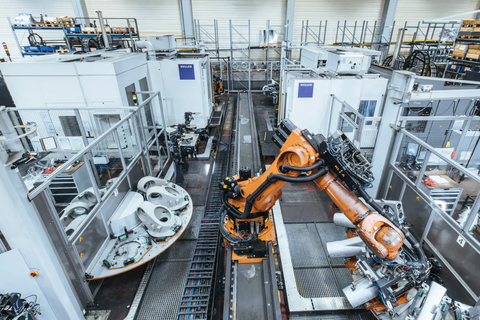THE SMART ROBOT FACTORY IN THE BROWNFIELD
AN APPLICATION EXAMPLE FROM THE OPEN INDUSTRY 4.0 ALLIANCE.
Open Industry 4.0 Alliance member KUKA demonstrates the freestyle in Industry 4.0: connecting a manufacturing cell to the cloud in ongoing production and providing it with all the features of a smart factory. This was only made possible thanks to teamwork between members of the alliance, first and foremost: Fujitsu, SAP and 3d Signals. Robots have built robots at KUKA before - now they are branching out into the cloud, with all the benefits of higher throughput, complete manufacturing transparency and predictive maintenance to minimize downtime.
Making the smart factory a reality requires cooperation. More than 85 national and global industrial companies have recognized this and joined forces with the Open Industry 4.0 Alliance in multilateral partnerships. The outstanding feature of this application example is the way it was implemented. The starting point was neither factory-new components nor a "test setup" in the corner of the KUKA machining shop. In line with the philosophy of the alliance, the application was implemented with components that have already been in operation for some time, i.e., in the so-called "brownfield". This also necessitated a few small retrofits, such as machines and software that did not originate from Alliance members but had to be integrated into the process.
Commenting on brownfield and retrofitting, Nils Herzberg, Alliance spokesperson and Senior Vice President and Global Head for Strategic Partnerships for Digital Supply Chain & Industrie 4.0 at SAP, explains, "The additional challenge we all face is that in the factories, some of these machines are 30 years old and they don't 'know', so to speak, what IIoT or Smart Factory means. So, there are a large number of retrofit requirements that relate to the interoperability issue, which I think adds an extra element to the complexity."
THE KUKA MANUFACTURING CELL IN THE IN-HOUSE MACHINING SHOP
"Our fully automated and networked robotic cell combines the analog and digital worlds of smart production," says Dr. Christian Liedtke, Head of Strategic Alliances at KUKA. A KR 500 L480-3MT robot picks up cast components using pneumatic grippers from Zimmer and feeds them to one of the Heller machining centers. After the components have been drilled and milled, they are deburred by the robot in the outer position and then removed. To be able to supply both machining centers from a total of four feed stations, the robot is installed on the KL 1500-3 linear unit. Senseforge from Altran can also be used to specifically check the temperature and cooling time of the tools. In networking the production cell with the CNC machines, KUKA relies on the modern Industry 4.0 architecture of the alliance. "In simplified terms, this architecture can be described by four levels: Manufacturing Components (systems), Edge Controller, IIoT- Platform and User Interface," Liedtke continues.
The connection to the digital world is made by networking all the components involved together in the cloud. "The data is collected in an edge gateway from Fujitsu and passed on to our operator cloud," reports Bastian Jehl, Industrial Internet of Things Solution Engineer at KUKA. "Services are then provided in the cloud itself, such as authentication, data processing, predictive maintenance and event evaluation. Currently, our workers get an overview of what is happening in the Heller machining centers using 3d Signals," adds Jehl. Using the Open Industry 4.0 Alliance architecture set up, the data runs via MQTT broker over the customer's own cloud. The customer will tailor the selection and presentation of data from a wide variety of sources to their needs using appropriate dashboard tools. "The customer has data sovereignty and decides how the data flows," Jehl said.
DIGITAL TWIN INCREASES PROJECT BENEFITS
The "digital twin" also plays a role in the project contribution of Alliance member SAP: The data of the physical product ultimately becomes viewable and analyzable as a digital twin in the KUKA cloud. Users can access the twin via the SAP Asset Intelligence Network (AIN), where documentation, certificates and maintenance instructions are stored in addition to the twin. The Open Industry 4.0 Alliance explains the benefits of the SAP AIN: A manufacturer makes its master data available for a specific model. Customers using the same machine simply adopt it and link it to their existing data.
The 3d Signals solution from Israel includes a cloud-based solution and an IoT device that applies real-time algorithms and AI to automatically detect machine health and machining process for a variety of machines and processes. Data flows from a Connectivity Box device to Fujitsu Edge via KUKA Cloud and ultimately to 3d Signals. The 3d Signals cloud presents a dashboard that clearly summarizes data and processes in the Heller cell for the user. The specialists also took over the integration of the Heller machining cells via sensors as Heller is not a member of the alliance.
"With our products, we stand for digital transformation in manufacturing with a focus on rapid deployment, full factory floor coverage and fast ROI for our customers," says Ofer Affias, Founder & CTO of 3d Signals. The company's dashboard solution visualizes real-time data and analytics for the two Heller machines in the shortest possible time through a non-invasive and machine-independent installation of multi-function sensors. The AI-based asset performance monitoring platform transforms the collected data into actionable insights for Kuka and provides numerous business intelligence and analytics tools in the cloud.
THE TWO PHASES OF THE PROJECT
In the software architecture as a whole, protocols and standards such as OPC-UA and MQTT are used, as well as proprietary protocols at the Fujitsu Edge level. On the cloud computing platform Microsoft Azure IoT Edge, the processes are orchestrated and passed on via message bus, the MQTT broker, to other instances, such as the 3d Signals Cloud, Siemens MindSphere and SAP AIN.
The reference project is divided into two phases: The first phase - the complete digitization of the manufacturing cell according to brownfield aspects during ongoing production - has been successfully completed. In the second phase, which is now underway, the processes are being continuously optimized on the basis of practical experience and predictive analysis methods.
NETWORKING COMPANIES WITH HIGH DIGITAL AFFINITY
The reference project at KUKA vividly demonstrates how partners’ competencies can be bundled in a targeted manner, thereby achieving very good results. The project impressively demonstrates the most important purpose of the Open Industry 4.0 Alliance – namely, to network like-minded industrial companies with high digital affinity to optimally exploit new synergies. This makes a decisive contribution to effectively advancing the Industry 4.0 idea and making practically ready-made digital workflows available to customers.

